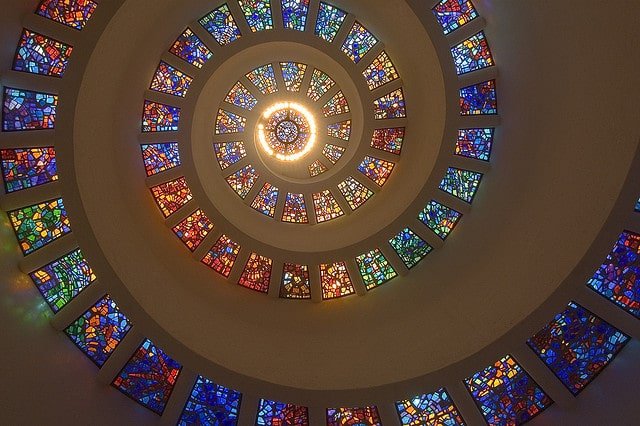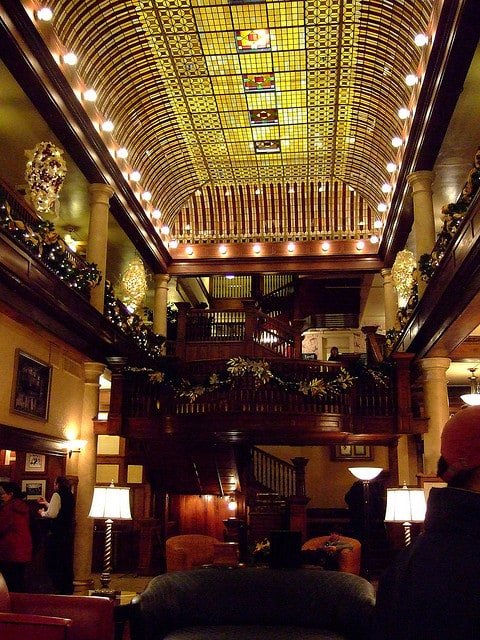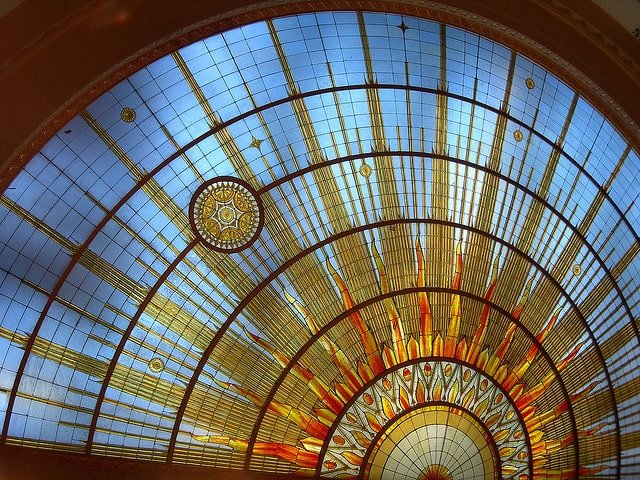Five of the Most Beautiful Stained Glass Ceilings in the U.S.
I’ve always loved stained glass. There is something magical about the way the light dances through the glass, creating colorful patterns on the surrounding structures. It’s even more magical being in a room with a stained glass ceiling. The colors of the glass can completely transform the atmosphere of the room, giving it an ethereal feeling.
Below you’ll find a list of some of the most beautiful stained glass ceilings in the United States. If you are traveling or live near one of these ceilings, be sure to check them out in person. Chances are you won’t be disappointed.
![Grand Army of the Republic (GAR) Rotunda, Chicago Cultural Center. Photo by Nheyob (Own work) [CC-BY-SA-3.0 (http://creativecommons.org/licenses/by-sa/3.0)], via Wikimedia Commons](wp-content/uploads/2014/02/Chicago_Cultural_Center_-_d.jpg)
#1 – The Chicago Cultural Center
![Chicago Cultural Center - Grand Staircase and Preston Bradley Hall with the Tiffany Glass Dome. Photo by Daderot. (Own work (I took this photo)) [GFDL (http://www.gnu.org/copyleft/fdl.html) or CC-BY-SA-3.0 (http://creativecommons.org/licenses/by-sa/3.0/)], via Wikimedia Commons](http://somecallmebeth.com/wp-content/uploads/2014/02/Chicago_Cultural_Center_-_G-300x225.jpg)
Today, it is a hub for visual, literary and performing arts, hosting more than 1,000 programs and exhibitions annually.
The architecture of the building itself is reason enough to visit. The crowning glory of the building are two fabulous stained glass domes. The first is located in the Grand Army of the Republic Rotunda. This dome features a Renaissance-inspired pattern and was designed by the firm of Healy and Millet.
The second dome is a stunning 38-foot Tiffany glass dome located in Preston Bradley Hall. The dome, which was designed by J.A. Holtzer, is said to be the largest Tiffany glass dome in the world.

#2 – The Glory Window, Thanks-Giving Square, Dallas, Texas
Located in the heart of Dallas, Texas, Thanks-Giving Square is a beautifully landscaped park that was designed to promote the concept of thankfulness. Throughout the park are scattered features that encourage quiet reflection. Near the main entrance of the park, you can find the Court of All Nations and the Wall of Praise, which features a mosaic inspired by Norman Rockwell’s “The Golden Rule”. Further in the park is a Bell Tower that sounds off every hour.
As you progress even further into the park you come to a small bridge that leads past a waterfall. Across the bridges is the Chapel of Thanksgiving. This small, spiral-shaped chapel features one of the most beautiful stained glass installations in the country. The ceiling of the chapel is made up of a series of stained glass panels that spiral upward, become lighter and lighter as they climb toward the center. This stunning ceiling is one of the largest horizontally-mounted stained glass installations in the world.
![Old Louisiana State Capitol, Baton Rouge, La. Photo by Niagara (Own work) [CC-BY-SA-3.0 (http://creativecommons.org/licenses/by-sa/3.0)], via Wikimedia Commons](wp-content/uploads/2014/02/Old_Louisiana_State_Capitol.jpg)
#3 – Old Louisiana State Capitol, Baton Rouge, Louisiana
Located in Baton Rouge, Louisiana’s Old State Capitol building is a castle-like building that housed the Louisiana State Legislature up until the late 1920s. Originally built by architect James Dankin in the mid-1800s, the building features a Neo-Gothic design that includes prominent castle turrets and crenellations.
During the Civil War, Union troops captured New Orleans and drove the seat of the government out of Baton Rouge. They quickly moved into the abandoned building, using it first as a prison, and then as a garrison for African-American troops. During this time, the building caught fire twice, leaving it completely gutted. In 1882, the architect William A Freret rebuilt the building, including a large stained glass dome.

#4 – Hotel Boulderado, Boulder, Colorado
If you are planning a trip to Boulder, Colorado, don’t miss the Hotel Boulderado. Built in 1909 by William Redding & Son, this hotel features beautiful architecture and a stunning stained glass canopy ceiling. The original ceiling was built using glass that was imported from Italy.
Unfortunately, however, the ceiling was damaged by a heavy snowfall in 1959. In the late 1970s, a large-scale renovation of the ceiling got underway. The renovation was completed in 2004, and the ceiling has been returned to its former glory.
Along with the amazing ceiling, the hotel features the original mosaic floor. There are also a number of historic artifacts on display throughout the hotel, making it a fun stop for anyone interested in history.

#5 – Common Council Chamber, City Hall, Buffalo, New York
Built in the early 1930s, Buffalo’s City Hall is a large, commanding structure with beautiful Art Deco inspired architecture. The building’s design is rich in symbolism, most of which pays homage to Buffalo’s industrial roots. For instance, the columns on the front of the building represent large nuts with rivet heads, while embossed portraits represent Buffalo’s working class including ironworkers, electricians, linesmen and engineers amongst others.
Inside, symbols representing the Iroquois Indians can be found throughout the building. One of the most prominent examples of this is in the Common Council Chamber. The ceiling of the chamber is a large, stained glass sunburst inspired by Iroquois art.
